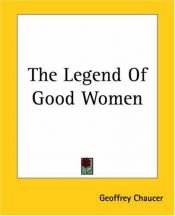The Legend of Good Women
Blurb
The Legend of Good Women is a poem in the form of a dream vision by Geoffrey Chaucer.The poem is the third longest of Chaucer’s works, after The Canterbury Tales and Troilus and Criseyde and is possibly the first significant work in English to use the iambic pentameter or decasyllabic couplets which he later used throughout the Canterbury Tales. This form of the heroic couplet would become a significant part of English literature no doubt inspired by Chaucer.
The prologue describes how Chaucer is reprimanded by the god of love and his queen, Alceste, for his works—such as Troilus and Criseyde—depicting women in a poor light. Criseyde is made to seem inconstant in love in that earlier work, and Alceste demands a poem of Chaucer extolling the virtues of women and their good deeds.
For thy trespas, and understond hit here:
Thou shalt, whyl that thou livest, yeer by yere,
The moste party of thy tyme spende
In making of a glorious Legende
Of Gode Wommen, maidenes and wyves,
That weren trewe in lovinge al hir lyves;
And telle of false men that hem bitrayen,
That al hir lyf ne doon nat but assayen
The poet recounts ten stories of virtuous women in nine sections.

 English
English Español
Español Deutsch
Deutsch
Member Reviews Write your own review
Be the first person to review
Log in to comment